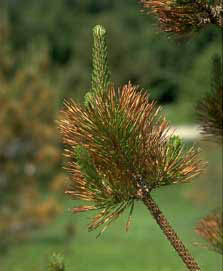The most diagnostic feature is the appearance of tiny, elongate, black lines which are formed by fungal tissue and run lengthwise along the infected part of the needle. Beneath this fungal tissue lie the individual fruiting bodies, called apothecia. Several fruiting bodies may be found on a single infected needle. Once the apothecia are mature, and environmental conditions are sufficiently damp, they will shoot out spores to infect the new needles. Symptoms will not appear on the newly infected needles until late that winter.
Fig. 1. Apothecia of Ploioderma needlecast
To control Ploioderma, use a registered fungicide to protect new growth in the spring. Apply the first treatment when the new growth is about 2 inches long and the needles are just emerging from the fascicles. Once the fungus begins to produce spores, it may continue to do so for about 6 weeks, so two additional treatments, at about 14 day intervals, may be necessary to protect the new growth as it expands. Also, select nursery stock carefully, and inspect it for a few years after planting. Ploioderma may be missed on nursery stock, because symptoms may not have shown up before the stock was dug.
